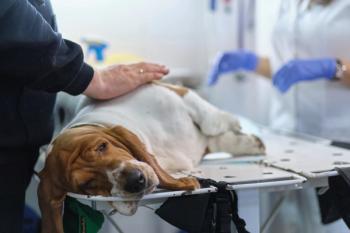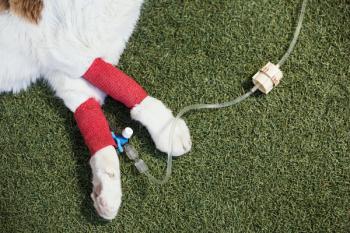
Canine thyroid carcinoma in 4-year-old American bulldog: Radiation oncology perspective
Dr. Isabella Pfeiffer provides the radiation oncology perspective on this challenging oncology case.
Isabella Pfeiffer, DMV DECVIM-CA (oncology), DACVR (radiation oncology)External beam radiation therapy is the treatment of choice for nonresectable thyroid carcinomas (Figure 9), and it can also be recommended for incompletely resected tumors.
Figure 9. A now 6-year-old castrated male American bulldog (the patient in this case) with a recurrent thyroid carcinoma being positioned for his radiation treatment on a Varian Clinac iX.The median survival time for infiltrative thyroid carcinomas treated with definitive radiation therapy alone was 24.5 months in one study of dogs free of metastatic disease at the time of diagnosis.1 Another study reported a progression free survival of 80% at one year and 72% at three years in dogs treated with definitive radiation therapy for nonresectable thyroid carcinomas. The median survival time was not reached.2
Definitive protocols involve daily radiation treatments (Monday through Friday or Monday-Wednesday-Friday) over three to four weeks to a minimum total dose of 45 Gy. The disadvantages of these protocols are the high cost, requirement for daily anesthesia (although this is generally well-tolerated) and the development of acute side effects toward the end of the treatment. For dogs with thyroid carcinoma undergoing irradiation of their larynx and neck, acute side effects include localized hair loss, dry to moist desquamation of the skin and mucositis (i.e. laryngitis, tracheitis and esophagitis). These side effects can lead to clinical signs such as coughing, difficulty or discomfort on swallowing, and inability or reluctance to eat.1,2 These signs are typically first seen during the last half of the radiation therapy protocol, progress for seven to 10 days after treatments are complete, and then start to heal. Mucositis usually heals within seven to 10 days, while the skin reaction may take a little longer to subside. Hair loss may be temporary or permanent, and it can take weeks to months before regrowth occurs. When hair regrows, the color will change, and dogs will exhibit leukotrichia as a late radiation side effect.
Late radiation side effects (those occurring six months or later after radiation is complete) of thyroid carcinomas, aside from leukotrichia and alopecia, can include tracheal and esophageal stenosis and fibrosis as well as laryngeal dysfunction with difficulty swallowing. Secondary tumor formation, spinal necrosis and bone necrosis are of lesser concern, as for most thyroid tumors the spinal cord and associated bony structures are not within the radiation field. Secondary cancer formation is also of very little concern as most dogs with thyroid cancers are older animals that, despite having a relatively good prognosis after radiation therapy, do not live long enough for a second cancer to develop. The risk for developing stenosis and fibrosis of the esophagus/larynx and trachea is low (estimated < 5%) when dogs are treated with a definitive protocol using small daily doses of radiation.
As thyroid tumors are generally slow-growing cancers, the response to radiation therapy can also be slow. One study described the time to maximum tumor regression ranging from eight to 22 months.2 Dogs with large tumors and severe clinical signs, such as dysphagia or dyspnea, may not respond quickly enough to radiation therapy to manage their clinical signs; those dogs may benefit more from surgical debulking before radiation therapy because of the slow regression of tumors. However, surgical debulking is not recommended in cases of invasive thyroid carcinoma because of the high risk of fatal hemorrhage, and therefore, treatment options for dogs with significant clinical signs at the time of diagnosis can be limited.
Even dogs with pulmonary metastasis may still respond favorably to definitive radiation therapy with a median survival time of 1.5 to two years.3 This study also described a palliative radiation protocol using a large dose of radiation once a week for four weeks with a median survival time of 1.8 years and reported that pulmonary metastasis at the time of diagnosis did not negatively impact survival time.3 Palliative protocols, however, carry a higher risk for detrimental late side effects, which is why radiation oncologists usually recommend definitive-type protocols for thyroid carcinomas.
Another treatment modality for thyroid tumors is treatment with radioactive iodine (131I) either alone or after incomplete surgical resection. One advantage is that it can potentially treat metastatic disease, whereas external beam radiation therapy only focuses on local disease. Survival times described in two studies are similar to those in other studies using external beam radiation therapy.4,5 Disadvantages of this treatment modality include the requirement for specialized radiation isolation for days and sometimes weeks after administration of the radioactive nuclide, and the potential for systemic side effects, such as gastrointestinal upset and in some cases severe bone marrow suppression leading to death.5 Few institutions offer this treatment for dogs with thyroid carcinoma because of the specialized needs for housing and personnel exposure risk to high doses of radiation. One study reported that 131I therapy can be effective in dogs with both functional or nonfunctional thyroid carcinomas5; however, it has been argued that this should be the treatment of choice only for dogs with functional thyroid tumors, as in nonfunctional tumors the uptake of radioactive iodine may be heterogeneous or minimal in some cases, compromising efficacy.
In summary, thyroid carcinoma is usually a slowly progressive cancer that can be successfully treated locally with surgery or external beam radiation therapy, and dogs can have long survival times despite pulmonary metastatic disease or gross disease at the time of treatment.
References
1. Pack L, Roberts RE, Dawson SD, et al. Definitive radiation therapy for infiltrative thyroid carcinoma in dogs. Vet Radiol Ultrasound 2001;42:471-474.
2. Thon AP, Marks SL, Feldman ES, et al. Prognostic factors and patterns of treatment failure in dogs with unresectable differentiated thyroid carcinomas treated with megavoltage irradiation. J Am Vet Med Assoc 2000;216:1775-1779.
3. Brearley MJ, Hayes AM, Murphy S. Hypofractionated radiation therapy for invasive thyroid carcinoma in dogs: a retrospective analysis of survival. J Small Anim Pract 1999;40:206-210.
4. Worth AJ, Zuber RM, Hocking M. Radioiodide (131I) therapy for the treatment of canine thyroid carcinoma. Aust Vet J 2005;83:208-214.
5. Turrel JM, McEntee MC, Burke BP, et al. Sodium iodide I 131 treatment of dogs with nonresectable thyroid tumors: 39 cases (1990-2003). J Am Vet Med Assoc 2006;229:542-548.
Newsletter
From exam room tips to practice management insights, get trusted veterinary news delivered straight to your inbox—subscribe to dvm360.





